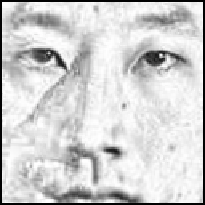Graphics Reference
In-Depth Information
(a)
(b)
(c) (d)
Fig. 1.
The results of processed image. (a) Original image. (b) Eye detection. (c) Effective field
(d) Standardization
Fig.2 illustrates the effect of iteration to recognition. In Fig.2 (a), when
t
<
70
,
the accuracy increases with
t
increasing, while
, the accuracy decreases be-
cause the invariant is affected by more shadow that develops gradually. In order to
clearly analyze the small
t
, we make a new experiment in which we apply
t
from 2 to
40 with 2 increasing. The result is showed in Fig.2 (b). Though we infer high ac-
curacy that should be found with small
t
, unexpectedly, the experiment demon-
strates reverse result. Low accuracy reveals that it is not reasonable to discard all
illumination to raise the accuracy. Furthermore, when
t
increases, the accuracy
improves well because some low frequency information are preserved in the ref-
lectance. Xie et al [10] pointed out that the low frequency contains basic informa-
tion of face which may offer additional content to distinguish different people in
their research on the effect of large- and small scale features to face recognition.
Whereas the retinex only uses high frequency and remove all low frequency, which
may lose important information. So we believe that some information should be
extracted to join in the invariant from low frequency (illumination) to improve face
recognition.
t
>
70




Search WWH ::

Custom Search